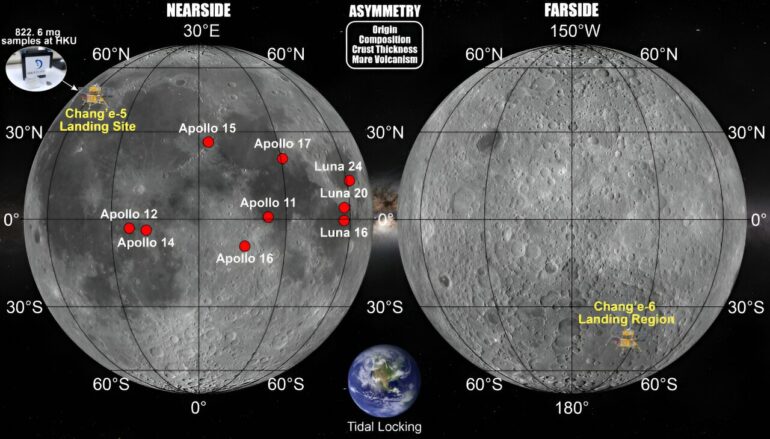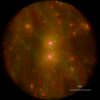The far side of the moon is a mysterious place that is never visible from the Earth. The most remarkable feature of the moon is its asymmetry between the lunar near side and far side in composition, crust thickness, and mare volcanism. Scientists have not yet reached a consensus on the origin of the lunar asymmetry due to the lack of far side samples, which is one of the most significant remaining questions of lunar science.
The Chang’e-6 mission, launched on May 3, 2024, and currently heading to the moon, is the world’s first lunar far side sample-return mission. It aims to return ~2 kg lunar soils to the Earth from the southern mare plain of the Apollo basin within the South Pole-Aitken basin, the largest known impact feature in the solar system. These samples contain enormous scientific potential that can be used to solve the lunar dichotomy conundrum and even reshape our knowledge of our closest neighbor.
As shown in a recent paper published in Earth and Planetary Science Letters, Dr. Yuqi Qian, Professors Joseph Michalski and Guochun Zhao from the Department of Earth Sciences at The University of Hong Kong (HKU) and their international collaborators have comprehensively studied the volcanism of the Apollo basin and its surroundings, which revealed the mysterious and diverse volcanism of the Chang’e-6 landing site with significant implications for the Chang’e-6 sample analysis and the origin of the lunar dichotomy.
The study has found that the Apollo basin has extensive volcanic activities lasting from the Nectarian (~4.05 billion years ago) to the Eratosthenian Period (~1.79 billion years ago). Volcanic activity in the region was significantly influenced by crustal thickness. Dikes in intermediate-thickness crust tend to stall beneath the crater floor, spreading laterally to form a sill and floor-fractured crater.
Dikes below the crust thinned by the Apollo basin event reached directly to the surface and erupted to form widespread lava flows, and dikes in thick crust stall before being able to reach the surface and form basaltic dike intrusions. “This fundamental finding indicates that the crustal thickness discrepancy between near side and far side may be the primary cause of lunar asymmetrical volcanism,” said Dr. Qian. “This can be tested by the returned Chang’e-6 samples.”
For the southern mare plain in the Apollo basin, where Chang’e-6 is going to land, there are at least two episodes of eruptions. The earlier one erupted ~3.34 billion years ago with low-Ti composition and covered the entire topographically low region between the Apollo peak ring and basin rim. The later eruption occurred ~3.07 billion years ago with high-Ti composition close to Chaffee S crater and flowed east with decreasing thickness until encountering proto-wrinkle ridges.
The authors suggested the high-Ti basalts in the west have the most abundant scientific meanings. Sampling it would return high-Ti basalts, underlying low-Ti basalts and exotic nonmare materials that were transported by impact events. Professor Michalski emphasized, “Diverse sample sources would provide important insights into solving a series of lunar scientific questions hidden in the Apollo basin.”
“The result of our research is a great contribution to the Chang’e-6 lunar mission. It sets a geological framework for completely understanding the soon-returned Chang’e-6 samples and will be a key reference for the upcoming sample analysis for Chinese scientists,” said Professor Guochun Zhao, Chair Professor of HKU Department of Earth Sciences and the co-author of the paper. “It is a large step for HKU where the university seeks excellence in planetary sciences and more participation in the national space program.”
HKU is the only university in Hong Kong that possesses lunar samples obtained by the Chang’e-5 mission from near side. Building on the foundation of this work, the geological team from HKU will also pursue the opportunity to acquire Chang’e-6 samples as well. This initiative aims to enable HKU to possess lunar samples representing both near side and far side, thus unlocking a new window of scientific exploration into the study of two lunar hemispheres.
More information:
Yuqi Qian et al, Long-lasting farside volcanism in the Apollo basin: Chang’e-6 landing site, Earth and Planetary Science Letters (2024). DOI: 10.1016/j.epsl.2024.118737
Provided by
The University of Hong Kong
Citation:
Geologists reveal mysterious and diverse volcanism in lunar Apollo Basin, Chang’e-6 landing site (2024, May 7)



